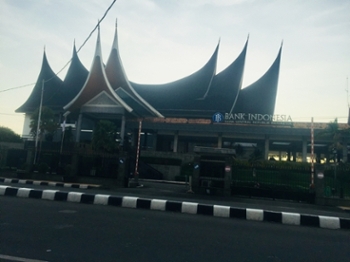Padang At A Glance
Padang, the capital city of the Indonesian province West Sumatra, is a spectacle upon first glance. The city itself is flat, lacking the skyscrapers I saw while connecting through the Indonesian capital of Jakarta. Situated on Sumatra’s western shore, Padang is not far from the infamous Ring of Fire, and frequently experiences earthquakes, severe thunderstorms, and rarely a tsunami. Ultimately, a vertical landscape just would not make sense for the city. The result is a vast landscape of one-story homes and shops, with the occasional multi-story building sticking out in the city’s horizon.
The average home in Padang includes a rusted tin roof and a clutter of laundry lines running from the back. However, government and military buildings are quite noticeably more developed. As an example, the Central Bank of Indonesia sits not far from the center of Padang, displaying a blend of traditional and modern architecture (see image below). The roof of the building represents buffalo horns to symbolize a Sumatran tale that is present in many forms around Padang. The legend tells that prior to the Dutch colonization of Indonesia, kings ruled the provinces and the powerful kingdom of Java attempted to take over several other provinces. When the King of Java threatened war with West Sumatra, the King of West Sumatra offered to avoid the loss of human life and settle the challenge by pitting a buffalo from each province against each other. The King of Java accepted, and eventually West Sumatra used a starved baby buffalo with iron-cast horns to defeat Java’s massive buffalo. As a result, the symbolism of the buffalo is present in architecture, at weddings, and throughout culture in Padang. Most notably, the natives of West Sumatra are known as the Minangkabau, which broken down translates to “winning buffalo”.

The Central Bank of Indonesia also represents something much more. I did not know what to expect when I came to Padang, but what I found is a unique economic situation. As I rode my motor scooter around the city, I began to notice something beyond the physical structure of the buildings. Food does not seem to be an issue for anyone, as there is literally a vendor or shop on every street. While Padang may not be up to western standards as far as roads and homes, there does not appear to be a “poor” area of town. It seemed to me like almost all of the residents of Padang at least had the “basics” per Indonesian standards. Tegnan Hilaire, an Ivory Coast Ex-Pat and lecturer at Andalas University in Padang, told me that poverty in Padang has a different standard than most of the world. Tegnan referenced that the “basics” in his native Ivory Coast included a shelter with a roof, while the basics in Padang seem to include a motorbike. This is a result of the Central Bank of Indonesia’s lending policy, and calling it a policy almost gives it too much weight. Any Indonesian with limited to no credit can walk into a bank and get a loan to buy a motorbike, and then a few months later walk back in and get a second. This is an interesting policy for a central bank of a country that is still recovering from years of economic downturn following an authoritarian regime and the birth of a democracy. Currently, one U.S. dollar equates to almost fourteen thousand Indonesian Rupiah, and I thought that Padang would reflect this economic status. However, the banks freely provide capital and, while this makes citizens happy with material goods, it will be interesting to see how it impacts the currency long-term.